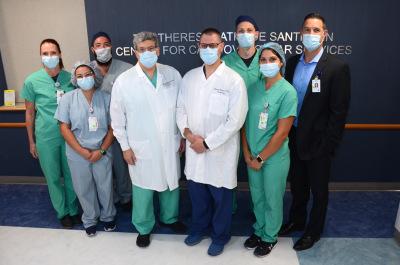In December 2019, Bob Wynne suffered a stroke, and the team at the Stroke & Brain Aneurysm Center at Good Samaritan sought to determine why. Not only did they discover the issue but they also used an advanced, minimally invasive technique to help prevent another stroke from occurring.
Strokes occur when the blood supply to the brain is interrupted, and they can have multiple causes. Strokes are caused by a blockage or narrowing of the artery supplying blood to the brain. They can also be caused by a rupture in a blood vessel in the brain leading to bleeding. A less common cause, but one that is often the culprit in younger stroke patients, is a patent foramen ovale (PFO) or a hole in the heart that failed to close after birth. Discovering the root cause can help doctors design a treatment that could prevent future strokes.
Bob’s medical team at Good Samaritan included interventional cardiologists Michael Happes, MD, and Chief of Interventional Cardiology David Reich, MD. The physicians determined that a PFO was likely the cause of Bob’s stroke. .This meant that the team could repair the defect with a minimally invasive technique, dramatically decreasing the odds that he would suffer another, potentially more devastating stroke.
Anywhere from 10–30 percent of adults have a PFO, a holdover from their days in the womb when, swimming in amniotic fluid, there was no need for blood to flow to the lungs to be oxygenated. Instead, blood is able to travel directly from the right to the left upper chamber of the heart through a small, flap-like opening. In most cases, the opening closes soon after birth. While a PFO rarely causes symptoms or medical problems, in some cases, small blood clots may move through the PFO to the brain, causing a stroke. Recent studies have shown that in patients with otherwise unexplained strokes, closing the PFO can prevent recurrences.
“As the only Comprehensive Stroke Center designated by both The Joint Commission and NYS Department of Health, Good Samaritan offers a range of the procedures in the treatment of stroke,” said Dr. Reich. “Not only can we remove a clot from cerebral circulation but also we can now perform minimally invasive PFO closure for patients when appropriate.”
This decision to do a PFO closure is made jointly by team that includes neurologists and cardiologists. Neurologists diagnose and treat stroke patients; they consult with cardiologists if they suspect a PFO might be a source of the clot that caused the patient’s stroke. Imaging studies confirm the presence of a PFO, and interventional cardiologists repair the opening using a minimally invasive technique in the Cardiac Catheterization Laboratory.
“The procedure involves inserting a catheter through a vein in the patient’s leg, and guiding it up to heart,” explained Dr. Happes. “We then deploy a PFO closure device, which becomes a permanent implant, to prevent the flap from opening.”
The device consists of a pair of wire mesh disks which eventually sit on either side of the flap. It is made of a medical grade metal alloy covered with a thin Gore-Tex fabric membrane that will eventually incorporate the body’s own tissue.
For Bob, a 62-year-old program manager at NYS tax department in Hauppauge, the procedure barely interrupted his routine.
“My doctor said, ‘Listen, you go in on Thursday, and go home Thursday night.’ I took off Friday, and was back to work on Monday,” he recalled. “There was no pain, no sensation, just a little scab by the groin; that was it.”
Bob and his wife, Maureen, who live in Bay Shore, appreciated the convenience of being able to receive this advanced treatment at Good Samaritan, close to home. His follow-up appointments were also local, at South Bay Cardiovascular in West Islip.
“The current American Heart Association recommendation is for patients aged 65 and younger who have PFO and a stroke with no clear cause to consider PFO closure. All patients are reviewed on a case-by-case basis,” said Dr. Happes.
“Multiple randomized clinical trials have shown that patients who have had a PFO closed with this device have done better than those on other preventive treatments such as aspirin to prevent clots,” said Dr. Reich.
For Bob and others like him, that equates to not only protection for his brain but also peace of mind.

